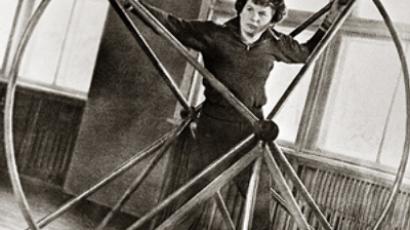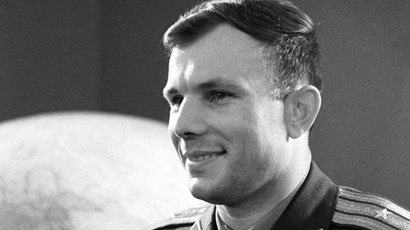First Lady of Space: Tereshkova’s flight TIMELINE
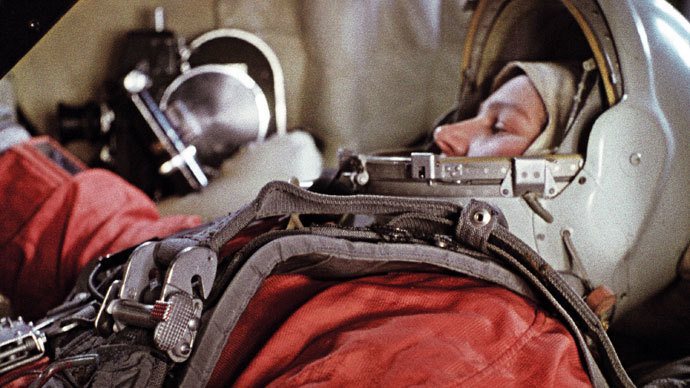
It is 50 years since the Vostok-6 rocket took Valentina Tereshkova to orbit, making her the first ever female to conquer space. RT brings the reconstructed timeline of the Russian's historic mission.
The selection of candidates for the mission began in early 1962. The first female cosmonaut had to meet certain criteria: a parachute jumper, younger than 30, less than 170 cm (5’ 7”) tall, and less than 70kg (154lbs).
Soviet Cosmonaut Valentina Tereshkova, born on March 6, 1937, in the Soviet village of Maslennikovo, Yaroslavl Region
Parents had migrated from Belarus. Father was a tractor-driver, mother worked at a textile plant
Tereshkova became the first woman in space on June 16,1963
Hero of the Soviet Union, awarded on June 22, 1963
First woman in the Russian Army to get a rank of Major-General, 1995 (in retirement since April 1997)
State Duma deputy, member of the majority United Russia party
Deputy Chairman of the State Duma Committee on Foreign Affairs
Got married to the 3rd Soviet cosmonaut Andrian Nikolaev in November 1963
On June 8, 1964, she gave birth to their daughter Elena - the first child in the world whose parents were both cosmonauts
Divorced since 1982
Finally, out of several hundred candidates, five were selected,
including 26-year-old Valentina Tereshkova – a regional champion
in skydiving who had 90 jumps under her belt.
On March 12, 1962, Tereshkova became a member of the cosmonaut
corps and, along with the other four candidates, began months of
tough training which included days spent in the complete silence
of a soundproof chamber, zero-gravity tests and exhausting
exercises in a heat chamber.
Tereshkova was last on the list of the candidates, but in the
1960s, political factors mattered a lot, and it was the
“proletarian” background, which scored her points.
On June 16, 1963, Tereshkova became the first woman in space. She
spent almost three days (70 hours 50 minutes) on the Vostok-6
spacecraft, which was launched from Baikonur Cosmodrome, in
present-day Kazakhstan. She orbited the earth 49 times. Another
Soviet spacecraft, Vostok-5 piloted by Valery Bykovsky, was in
space at the same time.
RT reconstructed the timeline of Tereshkova’s historic flight,
based on open sources, Tereshkova’s after-mission report and
interviews, and the published diaries of Nikolay Kamanin,
assistant commander-in-chief of the Air Force for space missions
from 1960 to 1971, who supervised cosmonauts'
training.
June 19, 1963
11:20 MSK: The Vostok-6 space capsule safely landed near
Baevo, in Altai, 620 km north-east of Karaganda.
“Both space craft landed 2 degrees north of the estimated
landing point,” Kamanin recalled.
“Communication and search teams made a lot of mistakes. We
received reports about the cosmonauts’ state of health only
several hours after the landing. We heard about Tereshkova
through the land communication lines; and the commander of the
aviation wing that circled over the landing site reported on
Bykovsky – he saw the space craft, a crowd of people, some
vehicles and the cosmonaut. After receiving verified reports on
the cosmonauts’ health condition, Korolyov called Moscow and
reported the safe landing. By night, it was clear that the second
group space flight of the Soviet cosmonauts – including the first
woman in space – was successfully completed.”

Tereshkova’s report: “After deployment of the parachute, I saw
the spacecraft underneath. The spacecraft and the seat landed
near me. We have to come up with a way to control the parachute
canopy, because I landed on my back. Some people ran up to me and
tried to help. The spacecraft was 400 meters away. A jet came in
an hour, two parachutists descended. In three hours, I was on the
phone with Khrushchev, reporting the successful completion of the
flight.”
According to Rossiyskaya Gazeta newspaper, Tereshkova’s landing
was quite harsh. The space capsule was shaped like a ball, so it
didn’t have the lift-to-drag ratio. Her descent had a ballistic
trajectory; therefore the first female cosmonauts had to deal
with a wide landing radius. Also they were ejected at 7 km, but
the space capsule parachute deployed only at 4 km.
"When I was ejected and saw what was underneath, I got
terrified, because there was a lake down there,” Valentina
Tereshkova said later. “My first thought was – darn, they send
one woman and now this woman will end up in the water!”
Tereshkova also remembers that it was very windy. “I had to remove the locks and unstrap the parachute. But it was impossible to control it, the canopy was huge, and the harness lines – very long. I was carried by the wind. So I had to ‘stand on my head’ for a little bit, finally I unstrapped the parachute, but ended up with a big bruise on my nose,” she recalled.
“Doctors had to conceal this bruise, because the beautiful
lady wouldn’t look good in front of all the bosses with a
shiner,” Tereshkova explained.
Some sources also claim that Tereshkova was almost unconscious
when she landed. The woman was immediately transported to a
hospital in Moscow. In the evening, the doctors reported that she
was out of the woods health wise.
So the next day they reenacted the landing and filmed it. They put Tereshkova in the capsule and actors played the people running up to it. One of the actors opened the capsule, and Tereshkova was sitting there, smiling. This footage was then shown all over the world.
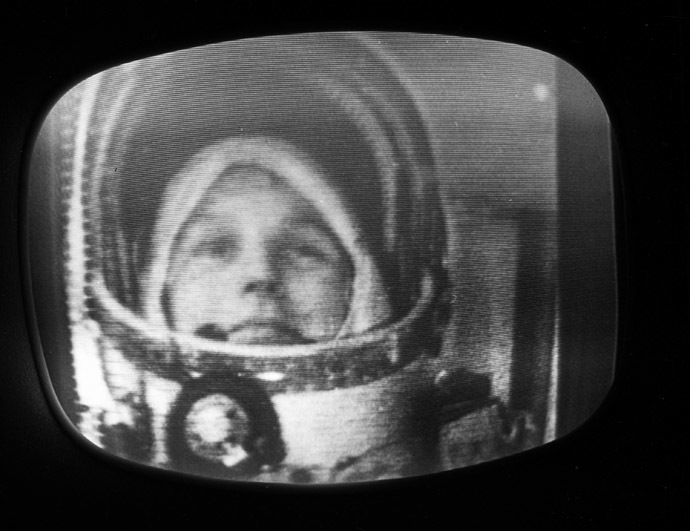
09:39 MSK: A command to activate the automatic
landing cycle was sent to Vostok-6 spacecraft.
‘Seagull’ performed manual orientation for landing and was maintaining the spacecraft in this position for 15 minutes.
“Tereshkova was extremely pleased and reported she had gotten through with her attitude control task,” Kamanin recalled.
Tereshkova’s report: “I have carried out all preparations for
the landing and reported readiness. Solar orientation control
system went on when the spacecraft was still in the Earth’s
shadow. I could hardly hear the retro pack went on. I reported on
having performed the commands via radiograms. The Earth was
behind my back. The modules detached abruptly. First the
spacecraft was moving steadily, but then it started swaying. When
the surface of the ship was burning, I could see flames flying
past the viewing port. After retraction, the cabin was filled
with smoke and wads. The chair quickly detaches and exits the
spacecraft in a very slow movement.”
June 18, 1963
10:00 MSK: Baikonur has started preparing all the data for the landings of both Vostoks. It was decided that Seagull will land on the 49th pass through the orbit, and Hawk – on the 82nd.
Tereshkova’s report: “I didn’t feel the spacesuit on me for the first 24 hours. On the second day I got nagging pain in my right shank, and on the third – it started troubling me. Full-pressure helmet was uncomfortable and tight on my shoulder, and the intercom headset was tight on my left ear... I could feel pain and itching on my head underneath the device. Air conditioning system worked well throughout the flight. At the takeoff the temperature inside the cabin was 30 degrees, at the end of the first 24 hours – 23 degrees. Then it fell to 12 degrees and maintained this temperature.”
Even though by the third day in space, Tereshkova was exhausted, she would not admit that. The mission control center tried to reach her for the last communication session before landing, but she would not receive calls. When the ground team turned the camera on, they found her asleep and had to wake her up to discuss upcoming landing and manual orientation.
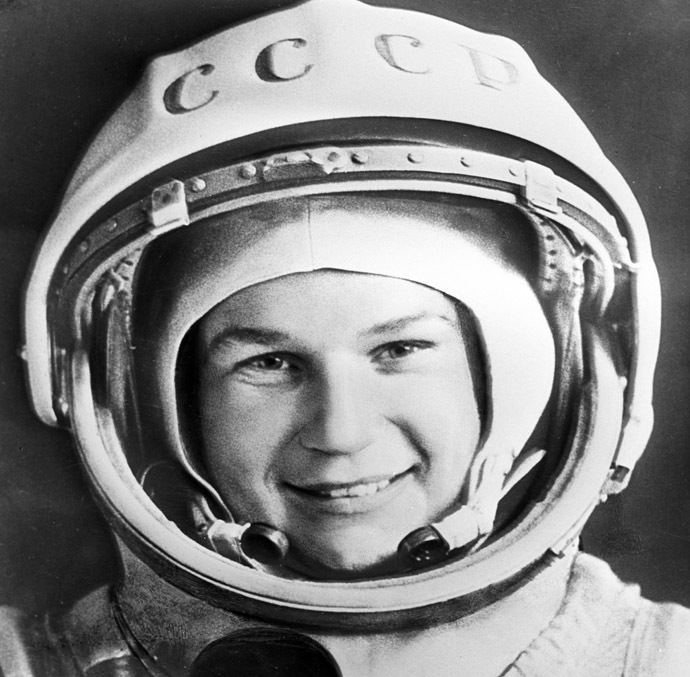
Tereshkova had tried orienting the spacecraft manually once, but then honestly admitted she had failed to do that. She was trying to turn Vostok-6 towards the Earth, but each time it would face the opposite direction. It aroused great concerns, as in case automatic orientation breaks down, returning the spaceship to the Earth would become impossible.
Tereshkova had been keeping silent about that emergency situation
on board for many years. Just last week, she finally made public
that there was an error in the control program that made the
spaceship ascend from orbit instead of descending. She reported
it to the MCC.
“I entered the data that I got from the Earth into the program,” she told the journalists last week.
Later, after the successful landing, Sergey Korolyov came up to
her and asked, as Valentina recalls: “My little Chayka,
please, don’t tell anybody about that”.
And she did not, for decades.
Tereshkova’s report: “Sanitary wipes are not wet enough and are
tiny. It would be great to have something for teeth cleaning. I
witnessed thunderstorms in the sky above South America. At night
you can easily distinguish cities. The Earth and the clouds are
beautifully lit by the moonlight. Constellations are difficult to
make out.”
June 17, 1963
10:07 MSK: Vostok-6 flew from North-West to South-East
over the cosmonauts’ house at Baikonur and two communication
sessions with Tereshkova were held.
The correspondent of the Komsomolskaya Pravda newspaper told
Tereshkova he had just had a phone conversation with her mother,
who had said she was proud of her daughter and was looking
forward to meeting her on Earth. Valentina responded: “Kisses
for my mom, the dearest person to me.”
Tereshkova’s report: "Working with the equipment is hard: I couldn’t reach the globe and other devices, so I had to loosen the harness. I was filming cities, clouds and the Moon. Filming and simultaneously putting down what you see is extremely difficult. I haven’t carried out biological tests as I failed to get the samples."
The zero gravity did not cause any discomfort for the cosmonaut.
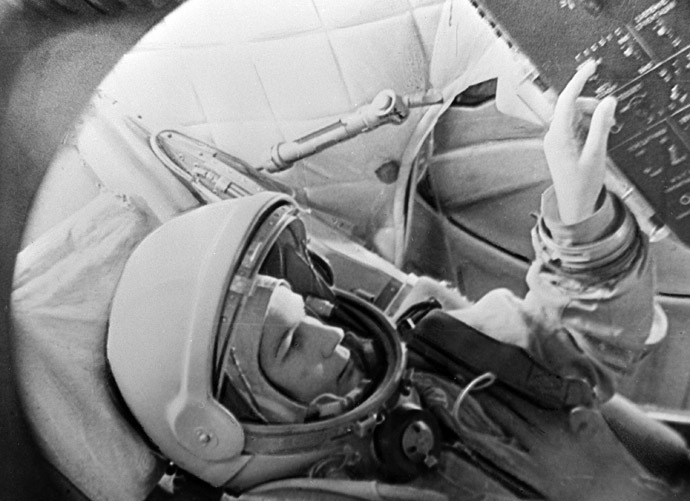
“My hands were floating in the air, so I felt like putting them away under the harness, and during training I felt like leaning against the chair,” Tereshkova said later, in her report.
Food in tubes, though, appeared to be quite a challenge.
"The bread is stale – I didn’t eat it. I was craving for black bread, potatoes and onions. The water is chilly and pleasant. Juices and beefsteaks were also fine. I vomited once, but that was not because of vestibular disturbance, that was because of the food," Tereshkova wrote.
Tereshkova didn’t keep the logbook as her two pencils had broken.
On the same day, Vostok-5 pilot Bykovsky said “Connection with
Chaika is excellent; she is humming songs to me.”
“During the first day we had excellent connection with Hawk,
on the second day until the afternoon it was satisfactory, and
then we lost it. But I could hear the ground talk to him, so it
was amazing to know Hawk was soaring in space somewhere next to
me.”
June 16, 1963
22:00 MSK: Tereshkova talked to Soviet leader, Nikita
Khrushchev, and reported to him on the mission.
Tereshkova’s report:
"The Vostok-6 launch was a very smooth one. We had good connection and I could hear all the commands. The gravity load was easy to bear… As the ship went into zero gravity, I had no painful sensations. I established connection with Hawk in the shadow of the Earth. I saw a star that shone three times as bright as Vega and I took it for Vostok-5."
On the same day, the cosmonaut noticed a mistake in the automatic
navigation software: the spacecraft was moving further and
further from the planet, instead of slowly going down towards it.
She reported that to the ground.
12:30 MSK: The Vostok-6 ship is successfully launched and
orbited.
Right before the launch, Tereshkova said her famous since then “Hey, sky! Take off your hat, I'm coming!” Later, when the cosmonaut was asked about this phrase, she told the journalists “I had never planned to say this. It was rather on the spur of the moment.”
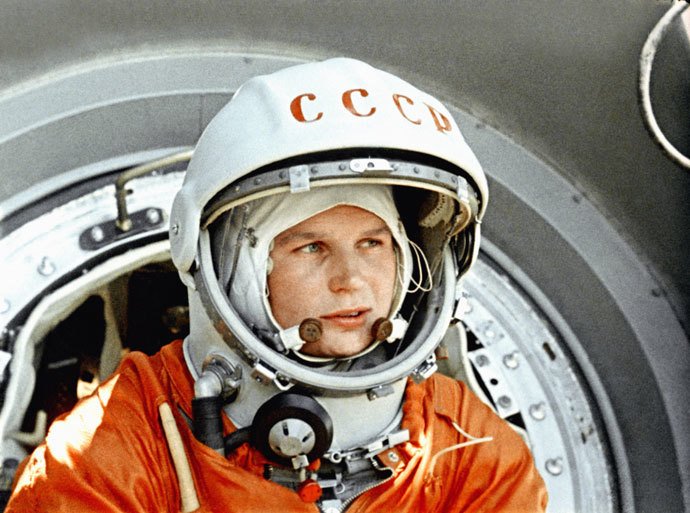
12:15 MSK: The bus brought ‘Seagull’ to the launching site. She reported to the Chairman of the State Commission the “Cosmonaut Tereshkova is ready for the launch.”
The lady was presented with a flower bouquet, which she
immediately handed over to Korolyov.
11:00 MSK: Tereshkova put on her space suit. The medical
check-up was also performed and it went well.
Walking up the stairs, to get into the spacecraft was pretty
difficult in a heavy spacesuit. That is not to mention the
jitters: Tereshkova’s pulse was at 140 beats per minute as she
was entering the ship. Once on board, it took her some ten to
fifteen minutes to establish radio connection with the ground and
then she reported on the equipment check-up.
On the day of the flight, Tereshkova told her family that she was
leaving to take part in a parachuting contest – up until the
successful launch the entire mission was classified. Her
mother only learnt about her heroic daughter on the radio.
June 15, 1963
19:00 MSK: The pre-launch team and space industry
officials meet with the Vostok-6 crew. Everyone brought
Tereshkova flowers and wished her a safe flight.
After the meeting, the girls changed to casual clothes and
together with Sergey Korolyov went on board Vostok-6. At night
Tereshkova and Solovyova went to the cosmonauts’ house and
started to prepare for the launch.
17:00 MSK: Tereshkova meets the pre-launch team. Moscow
decides to keep it secret that Tereshkova is an army officer in
the first media report about her mission and it was decided that
she must be wearing civilian clothes.
In the morning Vostok-6 was placed on the launch pad at Baikonur. The launch of the craft is scheduled for June 16, 12:30 Moscow time.

June 14, 1963
17:00 MSK: Vostok-5 was launched, piloted by Valery Bykovsky, code name Yastreb (Hawk). The flight would continue for about five days, with the cosmonaut landing successfully on June 19, after making 82 orbit passes. He would set a record of space flight duration. During the flight, the pilot would manage various systems of the spacecraft, establish radio connection with the Earth and between the ships and, also, conduct scientific research, mainly focused on how a human body changes in space.
June 10, 1963
22:30 MSK: The launch of Vostok-5 got cancelled due to a
series of strong solar flares. It means that radiation in space
may rise to a dangerous level for the pilot. It’s the first time
a launch is canceled.

June 9, 1963
09:00 MSK: Vostok-5 ship was prepared for the launch.
On the very same day, the cosmonauts and the pre-launch team took
a motorboat trip along the Syr Darya River and cooked fish soup
together.

June 8, 1963
17:00 MSK: The State Space Commission meeting. The
chairman of the commission suddenly asked a question: ‘Should
we mention that Tereshkova is an officer when we first announce
her flight?” The majority supported introducing her as the
Air Force Officer.
It was decided to launch Vostok-6 with a female cosmonaut two
days after the launch of Vostok-5 piloted by a male cosmonaut.
Under the plan, the man was to spend two days in space alone;
then both craft would stay together for three days and land at
the same time.
The same day, Tereshkova boarded her Vostok-6 and examined the
craft and its equipment together with the lead engineer.
“Tereshkova makes a very good impression on everyone. She
treats people equally; she is full of tact and dignity,”
Nikolay Kamanin, the man in charge of cosmonauts training,
recalled in his diaries.
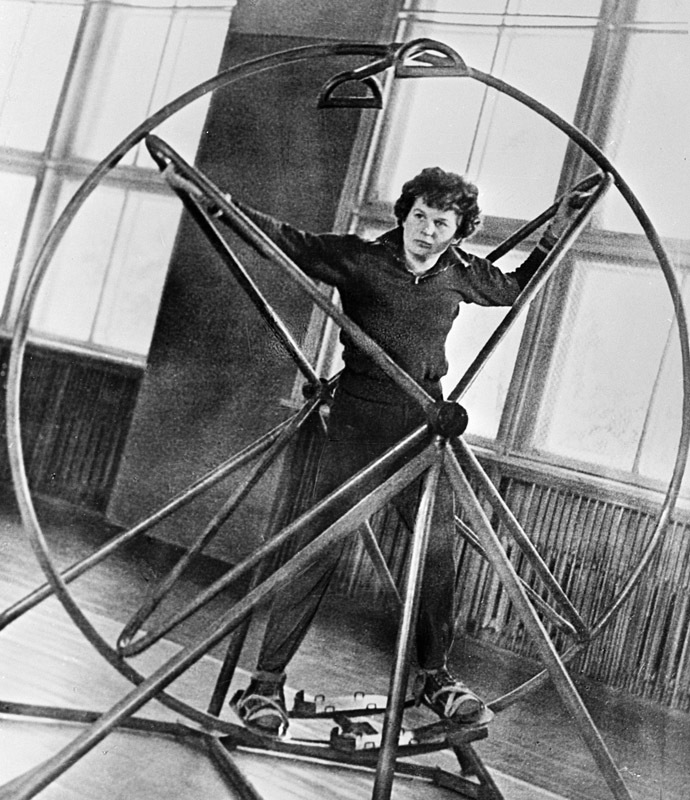
June 5, 1963
Kamanin held a training session with all cosmonauts, doctors and
other specialists to ensure a common understanding of 37
instructions that everyone – both on Earth and in orbit – were
obliged to know.
The teams also agreed to introduce code words that could be used
in open radio talks during the flights.
For instance, when a cosmonaut reports that “I am feeling
fine, the spacecraft’s equipment is working fine” it means a
space mission should continue as normal as there are no concerns
about health or equipment. When they say “well” instead of
“fine” it would mean that a cosmonaut is not really sure
they would be able to complete their mission. The word
“satisfactory” in a report would mean that the flight
should be terminated.

June 4, 1963
The State Space Commission held a meeting on launching the Vostoks spacecraft – their readiness to go into orbit and flight missions. At the gathering, Jr. Lt. Tereshkova was approved to pilot Vostok-6, and Major Bykovsky – Vostok-5.

June 3, 1963
09:00 AM: Tereshkova, Solovyova and Ponomaryova start trying on their spacesuits and adjusting harnesses and chairs. Tereshkova’s code name was Chaika, or Seagull in Russian, and there was a picture of the bird embroidered on the shoulder of her heat-protective suit.

June 1, 1963
10:00 MSK: Tereshkova, her back-ups Irina Solovyova and Valentina Ponomaryova, and a group of 35 people including the first spaceman Yuri Gagarin arrived at Baikonur space launch facility by Antoshin AN-10 plane. Sergey Korolyov and others met them at the site.














